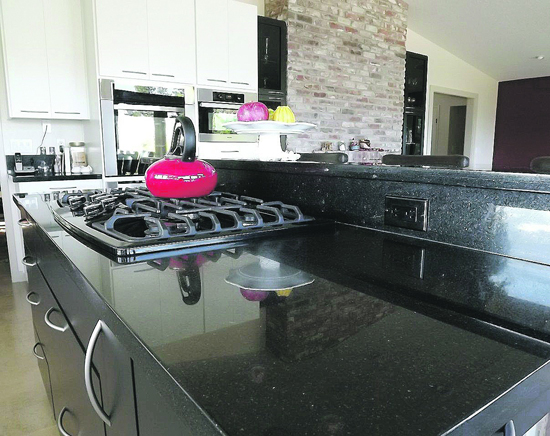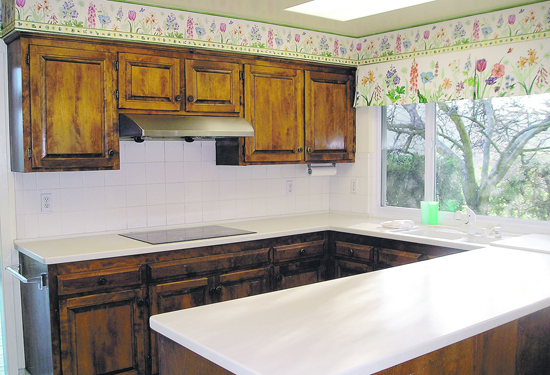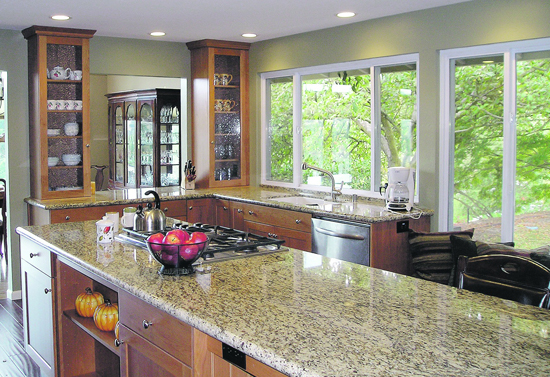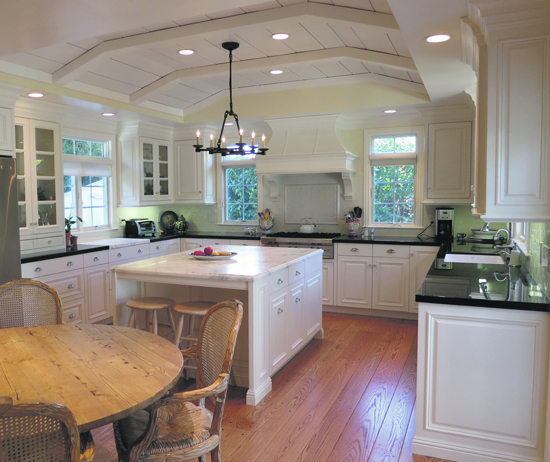| | Published January 16th, 2013
| Counter Intelligence: Kitchen Surface Choices Abound
| | By Cathy Dausman |  | | Moraga resident Suzanne Bare chose black "Galaxy" granite to emphasize her black and white kitchen remodel.
"I love how the light reflects," she said. Photo Cathy Dausman
|
Kitchen countertops may have disappeared under decorations and piles of dishes as families gathered to celebrate the holidays, but wiping the crumbs away and scrubbing the surfaces clean may have left you pining for a newer surface.
 Take your pick!
Take your pick!
 Durability, heat-resistance, crack resistance, cost, looks and availability all figure into choosing a surface with which to clad your countertops. Original kitchen counters in older Lamorinda houses were likely made of laminate or tile. An inexpensive material, laminate has such a low heat resistance that even a hot beverage could discolor or crack the surface.
Durability, heat-resistance, crack resistance, cost, looks and availability all figure into choosing a surface with which to clad your countertops. Original kitchen counters in older Lamorinda houses were likely made of laminate or tile. An inexpensive material, laminate has such a low heat resistance that even a hot beverage could discolor or crack the surface.
 Laminate is still available today in ready-made lengths at home improvement stores. Orindan Robin Bradley's kitchen is "vintage 1958," and still has the eight-inch white tiles to prove it. She says it still looks pretty good. "It's basic, durable, and you can scrub it," Bradley says. The downfall with a tile surface is the grout, which over time becomes stained or deteriorates.
Laminate is still available today in ready-made lengths at home improvement stores. Orindan Robin Bradley's kitchen is "vintage 1958," and still has the eight-inch white tiles to prove it. She says it still looks pretty good. "It's basic, durable, and you can scrub it," Bradley says. The downfall with a tile surface is the grout, which over time becomes stained or deteriorates.
 When asked to select a new countertop material, Bradley replied "I'd probably choose a new synthetic recycled material." Some homeowners replaced their laminate counters in the 1970s with a fused acrylic solid surface, but realtor Diane Reilly says that even that look is no longer popular. And she adds: "I don't know of anybody doing tile." Granite, says Reilly, has become an affordable go-to material.
When asked to select a new countertop material, Bradley replied "I'd probably choose a new synthetic recycled material." Some homeowners replaced their laminate counters in the 1970s with a fused acrylic solid surface, but realtor Diane Reilly says that even that look is no longer popular. And she adds: "I don't know of anybody doing tile." Granite, says Reilly, has become an affordable go-to material.
 Designer Suzanne Warrick agrees because granite is one of the most heat-tolerant counter top materials. Granite is naturally formed under extraordinarily high temperatures combined with very high pressure. A hot pan directly from the oven can be placed on a granite counter without fear of leaving marks or stains. You can't often do that with other natural stones. Marble, soapstone, slate and limestone are all only moderately resistant to heat. Granite costs range from $15 to $85 per square foot, depending on availability.
Designer Suzanne Warrick agrees because granite is one of the most heat-tolerant counter top materials. Granite is naturally formed under extraordinarily high temperatures combined with very high pressure. A hot pan directly from the oven can be placed on a granite counter without fear of leaving marks or stains. You can't often do that with other natural stones. Marble, soapstone, slate and limestone are all only moderately resistant to heat. Granite costs range from $15 to $85 per square foot, depending on availability.
 When Suzanne and Lance Bare of Moraga remodeled their kitchen recently, they chose a black and white color scheme and went with black granite counter tops flecked with white. They love how the light reflects off a surface simultaneously dark and light.
When Suzanne and Lance Bare of Moraga remodeled their kitchen recently, they chose a black and white color scheme and went with black granite counter tops flecked with white. They love how the light reflects off a surface simultaneously dark and light.
 Lamorinda Weekly writer Cathy Tyson chose black quartz for her home's shiny new kitchen counters: "We specifically wanted something neutral, since we chose a jazzy illuminated glass backsplash." While Tyson says she likes the new countertops, "they really do show every darn fingerprint and drip."
Lamorinda Weekly writer Cathy Tyson chose black quartz for her home's shiny new kitchen counters: "We specifically wanted something neutral, since we chose a jazzy illuminated glass backsplash." While Tyson says she likes the new countertops, "they really do show every darn fingerprint and drip."
 Marble's polished surface can be etched from citrus or perfume, so clean up spilled lemon juice quickly, and keep the Channel No. 5 off the counter! And if your New Year's Eve champagne landed atop someone's marble counter, you'd better hope the surface had a honed, matte finish rather than a polished high-gloss finish - you're less likely to see nicks, scratches or imperfections with a honed finish.
Marble's polished surface can be etched from citrus or perfume, so clean up spilled lemon juice quickly, and keep the Channel No. 5 off the counter! And if your New Year's Eve champagne landed atop someone's marble counter, you'd better hope the surface had a honed, matte finish rather than a polished high-gloss finish - you're less likely to see nicks, scratches or imperfections with a honed finish.
 Recycled glass products, while as durable as granite for counters, offer less heat tolerance. Those who select recycled glass get a sustainable, eco-friendly countertop and the knowledge they are keeping materials out of landfills. The heat resistance of recycled glass largely depends on the types of glass that are used.
Recycled glass products, while as durable as granite for counters, offer less heat tolerance. Those who select recycled glass get a sustainable, eco-friendly countertop and the knowledge they are keeping materials out of landfills. The heat resistance of recycled glass largely depends on the types of glass that are used.
 Poured concrete countertops are highly heat resistant, and can be custom colored, but concrete, Warrick warns, is guaranteed to crack. It is also a relatively porous material. She says colored concrete was used for countertops in many of the Craftsman houses in Oakland's Rockridge area.
Poured concrete countertops are highly heat resistant, and can be custom colored, but concrete, Warrick warns, is guaranteed to crack. It is also a relatively porous material. She says colored concrete was used for countertops in many of the Craftsman houses in Oakland's Rockridge area.
 Residential countertops can also be made of stainless steel or copper. Stainless steel is regularly used in commercial kitchens because it cleans well, but its surface scratches fairly easily. Additionally, heat may cause metal counters to discolor, but stains can usually be minimized using special solutions or mild abrasives. Be careful not to allow cold foods to come in contact with warm metal countertops during meal preparation, because metal retains heat so well it could easily promote the growth of harmful bacteria. Butcher block countertops have the same problem, as the wood surfaces can trap and transfer bacteria from raw meat or poultry.
Residential countertops can also be made of stainless steel or copper. Stainless steel is regularly used in commercial kitchens because it cleans well, but its surface scratches fairly easily. Additionally, heat may cause metal counters to discolor, but stains can usually be minimized using special solutions or mild abrasives. Be careful not to allow cold foods to come in contact with warm metal countertops during meal preparation, because metal retains heat so well it could easily promote the growth of harmful bacteria. Butcher block countertops have the same problem, as the wood surfaces can trap and transfer bacteria from raw meat or poultry.
 So before investing remodel dollars on a countertop upgrade, do your homework. Talk to contractors, ask your neighbors and friends and decide what's most important in your meal-prep area: durability, heat-resistance, crack resistance, cost, looks and availability. You can't have it all, and once it's installed, you can't take it with you!
So before investing remodel dollars on a countertop upgrade, do your homework. Talk to contractors, ask your neighbors and friends and decide what's most important in your meal-prep area: durability, heat-resistance, crack resistance, cost, looks and availability. You can't have it all, and once it's installed, you can't take it with you!

|
 | | "Before" shot of a 1970s era fused acrylic solid surface counter. Photos Cathy Dausman
|  | | The "after" photo of the acrylic fused counter tops
|  | | Stevenson Construction and Kathleen Burke Interior Design, both in Lafayette, created this black and white kitchen in a Happy Valley home with a designated space for baking, preparing bread and making sandwiches. Areas were delineated using white marble for the island and a section below the window on the back counter. By lowering the marble a quarter inch below the rest of the countertop, the window baking station allows for easy clean-up of crumbs and baking flour.
Photo Stevenson Construction
| | | | | | | Advertisement | | |
| | | print story
Before you print this article, please remember that it will remain in our archive for you to visit anytime.
download pdf
(use the pdf document for best printing results!) | | | Comments | | |
| | | | | | | | | | | | | | | | |





